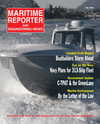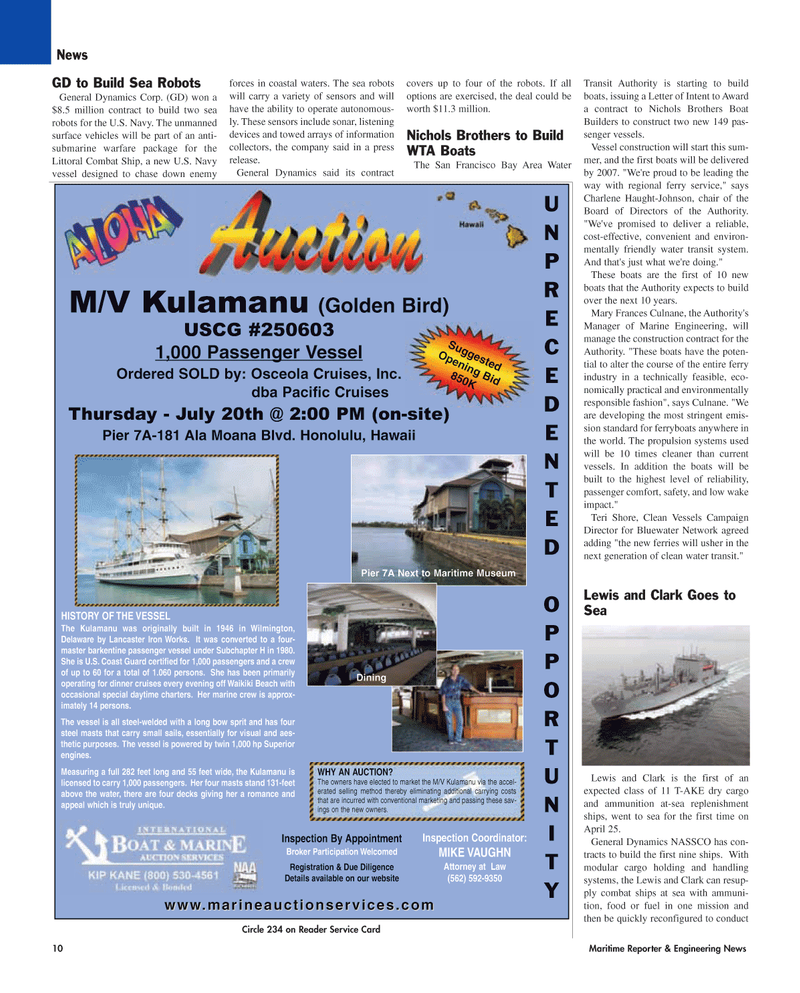
Page 10: of Maritime Reporter Magazine (May 2006)
The Marine Enviroment
Read this page in Pdf, Flash or Html5 edition of May 2006 Maritime Reporter Magazine
GD to Build Sea Robots
General Dynamics Corp. (GD) won a $8.5 million contract to build two sea robots for the U.S. Navy. The unmanned surface vehicles will be part of an anti- submarine warfare package for the
Littoral Combat Ship, a new U.S. Navy vessel designed to chase down enemy forces in coastal waters. The sea robots will carry a variety of sensors and will have the ability to operate autonomous- ly. These sensors include sonar, listening devices and towed arrays of information collectors, the company said in a press release.
General Dynamics said its contract covers up to four of the robots. If all options are exercised, the deal could be worth $11.3 million.
Nichols Brothers to Build
WTA Boats
The San Francisco Bay Area Water
Transit Authority is starting to build boats, issuing a Letter of Intent to Award a contract to Nichols Brothers Boat
Builders to construct two new 149 pas- senger vessels.
Vessel construction will start this sum- mer, and the first boats will be delivered by 2007. "We're proud to be leading the way with regional ferry service," says
Charlene Haught-Johnson, chair of the
Board of Directors of the Authority. "We've promised to deliver a reliable, cost-effective, convenient and environ- mentally friendly water transit system.
And that's just what we're doing."
These boats are the first of 10 new boats that the Authority expects to build over the next 10 years.
Mary Frances Culnane, the Authority's
Manager of Marine Engineering, will manage the construction contract for the
Authority. "These boats have the poten- tial to alter the course of the entire ferry industry in a technically feasible, eco- nomically practical and environmentally responsible fashion", says Culnane. "We are developing the most stringent emis- sion standard for ferryboats anywhere in the world. The propulsion systems used will be 10 times cleaner than current vessels. In addition the boats will be built to the highest level of reliability, passenger comfort, safety, and low wake impact."
Teri Shore, Clean Vessels Campaign
Director for Bluewater Network agreed adding "the new ferries will usher in the next generation of clean water transit."
Lewis and Clark Goes to
Sea
Lewis and Clark is the first of an expected class of 11 T-AKE dry cargo and ammunition at-sea replenishment ships, went to sea for the first time on
April 25.
General Dynamics NASSCO has con- tracts to build the first nine ships. With modular cargo holding and handling systems, the Lewis and Clark can resup- ply combat ships at sea with ammuni- tion, food or fuel in one mission and then be quickly reconfigured to conduct
M/V Kulamanu (Golden Bird)
USCG #250603 1,000 Passenger Vessel
Ordered SOLD by: Osceola Cruises, Inc. dba Pacific Cruises
Thursday - July 20th @ 2:00 PM (on-site)
Pier 7A-181 Ala Moana Blvd. Honolulu, Hawaii
Suggested
Opening Bid 850K
Pier 7A Next to Maritime Museum
WHY AN AUCTION?
The owners have elected to market the M/V Kulamanu via the accel- erated selling method thereby eliminating additional carrying costs that are incurred with conventional marketing and passing these sav- ings on the new owners.
Inspection By Appointment
Broker Participation Welcomed
Registration & Due Diligence
Details available on our website
Inspection Coordinator:
MIKE VAUGHN
Attorney at Law (562) 592-9350
HISTORY OF THE VESSEL
The Kulamanu was originally built in 1946 in Wilmington,
Delaware by Lancaster Iron Works. It was converted to a four- master barkentine passenger vessel under Subchapter H in 1980.
She is U.S. Coast Guard certified for 1,000 passengers and a crew of up to 60 for a total of 1.060 persons. She has been primarily operating for dinner cruises every evening off Waikiki Beach with occasional special daytime charters. Her marine crew is approx- imately 14 persons.
Measuring a full 282 feet long and 55 feet wide, the Kulamanu is licensed to carry 1,000 passengers. Her four masts stand 131-feet above the water, there are four decks giving her a romance and appeal which is truly unique.
The vessel is all steel-welded with a long bow sprit and has four steel masts that carry small sails, essentially for visual and aes- thetic purposes. The vessel is powered by twin 1,000 hp Superior engines. www.marineauctionservices.com
U
N
P
R
E
C
E
D
E
N
T
E
D
O
P
P
O
R
T
U
N
I
T
Y
Dining
Circle 234 on Reader Service Card 10 Maritime Reporter & Engineering News
News
MR MAY2006 #2 (9-16).qxd 5/8/2006 11:07 AM Page 10

 9
9

 11
11
